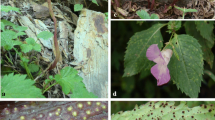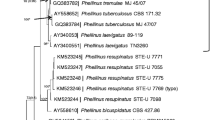Abstract
Puccinia psidii is an important pathogen considered a threat to plants of the Myrtaceae around the world. Morphological variability has created misunderstanding around the classification of this pathogen. Due to the obligately biotrophic nature of P. psidii, the age of the material on which the original description was based, and the poor condition of its DNA, there has been no clear genetic characterization of the species. An epitype is therefore designated for P. psidii for precise application of this taxon name. A morphological description and DNA characterization are provided from the epitype, obtained from the same location and host of the lectotype, also designated herein. Morphologically, the epitype is identical to the original material and phylogenetic and microsatellite analyses show that the epitype is representative of P. psidii from guava in Brazil.



Similar content being viewed by others
References
Arthur JC (1922) Uredinales - Aecidiaceae. N Am Flora 7:481–540
Berndt R (2011) Taxonomic revision of Endoraecium digitatum (rust fungi, Uredinales) with description of four new species from Australia and Hawaii. Mycol Prog 10:497–517
Cai L, Udayanga D, Manamgoda DS, Maharachchikumbura SSN, McKenzie EHC, Guo LD, Liu XZ, Bahkali A, Hyde KD (2011) The need to carry out re-inventory of plant pathogenic fungi. Trop Plant Pathol 36:205–213
Carnegie AJ, Cooper K (2011) Emergency response to the incursion of an exotic myrtaceous rust in Australia. Australas Plant Pathol 40:346–359
Carnegie AJ, Lidbetter JR (2012) Rapidly expanding host range for Puccinia psidii sensu lato in Australia. Australas Plant Pathol 41:13–29
Carnegie AJ, Lidbetter JR, Walker J, Horwood MA, Tesoriero L, Glen M, Priest MJ (2010) Uredo rangelii, a taxon in the guava rust complex, newly recorded on Myrtaceae in Australia. Australas Plant Pathol 39:463–466
Chatasiri S, Ono Y (2008) Phylogeny and taxonomy of the Asian grapevine leaf rust fungus, Phakopsora euvitis, and its allies (Uredinales). Mycoscience 49:66–74
Coutinho TA, Wingfield MJ, Alfenas AC, Crous PW (1998) Eucalyptus rust: a disease with the potential for serious international implications. Plant Dis 82:819–825
Feau N, Vialle A, Allaire M, Tanguay P, Joly DL, Frey P, Callan BE, Hamelin RC (2009) Fungal pathogen (mis-) identifications: a case study with DNA barcodes on Melampsora rusts of aspen and white poplar. Mycol Res 113:713–724
Feau N, Vialle A, Allaire M, Maier W, Hamelin RC (2011) DNA barcoding in the rust genus Chrysomyxa and its implications for the phylogeny of the genus. Mycologia 103:1250–1266
Gardes M, Bruns TD (1993) ITS primers with enhanced specificity for basidiomycetes- application to the identification of mycorrhizae and rusts. Mol Ecol 2:113–8
Giblin F (2013) Myrtle rust report: New Caledonia. Assessment of myrtle rust situation in New Caledonia. University of the Sunshine Coast Maroochydore, Queensland
Glen M, Tommerup IC, Bougher NL, O’Brien PA (2002) Are Sebacinaceae common and widespread ectomycorrhizal associates of Eucalyptus species in Australian forest? Mycorrhiza 12:243–247
Glen M, Alfenas AC, Zauza EAV, Wingfield MJ, Mohammed C (2007) Puccinia psidii: a threat to the Australian environment and economy - a review. Australas Plant Pathol 36:1–16
Graça RN, Ross-Davis AL, Klopfenstein NB, Kim M-S, Peever TL, Cannon PG, Aun CP, Mizubuti ESG, Alfenas AC (2013) Rust disease of eucalypts, caused by Puccinia psidii, did not originate via host jump from guava in Brazil. Mol Ecol 22:6033–6047
Huelsenbeck JP, Ronquist F (2001) MRBAYES: Bayesian inference of phylogenetic trees. Bioinformatics 17:754–755
Hyde KD, Zhang Y (2008) Epitypification: should we epitypify? J Zhejiang Univ (Sci) 9:842–846
Jackson HS (1931) The rusts of South America based on the Holway collections. Mycologia 23:463–503
Kawanishi T, Uematsu S, Kakishima M, Kagiwada S, Hamamoto H, Horie H, Namba S (2009) First report of rust disease on ohia and the causal fungus, Puccinia psidii, in Japan. J Gen Plant Pathol 75:428–443
Kroop BR, Albee S, Flint KM, Zambino P, Szabo LJ, Thomson SV (1995) Early detection of systematic rust infections of Dyers Woad (Isatis tinctori L.) using polymerase chain reaction. Weed Sci 43:467–472
Langrell SRH, Glen M, Alfenas AC (2008) Molecular diagnosis of Puccinia psidii (guava rust) - a quarantine threat to Australian eucalypt and Myrtaceae biodiversity. Plant Pathol 57:687–701
Larkin MA, Blackshields G, Brown NP, Chenna R, McGettigan PA, McWilliam H, Valentin F, Wallace IM, Wilm A, Lopez R, Thompson JD, Gibson TJ, Higgins DG (2007) Clustal W and Clustal X version 2.0. Bioinformatics 23:2947–2948
Laundon GF, Waterston JM (1965) Puccinia psidii. CMI descriptions of plant pathogenic fungi and bacteria No. 56. Commonwealth Mycology Institute, Kew
Loop L, La Rosa AM (2008) An analysis of the risk of the introduction of additional strains of the rust Puccinia psidii Winter (‘Ohi’a rust) to Hawai’i. U.S. Geological Survey Open File Report no. 1008
MacLachlan JD (1938) A rust of the pimento tree in Jamaica, British West Indies. Phytopathology 28:157–170
Marlatt RB, Kimbrough JW (1979) Puccinia psidii on Pimento dioica in south Florida. Plant Dis 68:510–512
McNeill J, Barrie FR, Buck WR, Demoulin V, Greuter W, Hawksworth DL, Herendeen PS, Knapp S, Marhold K, Prado J, Prud’homme Van Reine WF, Smith GF, Wiersema JH, Turland NJ (2012) International Code of Nomenclature for algae, fungi and plants (Melbourne Code) adopted by the eighteenth international botanical congress Melbourne, Australia, July 2011. Regnum Vegetabile 154. Hamburg, Germany. Koeltz scientific books
Mellano V (2006) Rust on myrtle found in San Diego county. Health Gard Health Home Newsl 1:3
Pegg GS, Brawner JT, Lee DJ (2014) Screening Corymbia populations for resistance to Puccinia psidii. Plant Pathol 63:425–436
Pérez CA, Wingfield MJ, Altier NA, Simeto S, Blanchette RA (2011) Puccinia psidii infecting cultivated eucalyptus and native myrtaceae in Uruguay. Mycol Prog 10:273–282
Raeder U, Broda P (1985) Rapid preparation of DNA from filamentous fungi. Lett Appl Microbiol 1:17–20
Roux J, Greyling I, Coutinho TA, Verleur M, Wingfield MJ (2013) The myrtle rust pathogen, Puccinia psidii, discovered in Africa. IMA Fungus 4:155–159
Ruiz RAR, Alfenas AC, Ferreira FA (1989) Influência da temperatura, do tempo de molhamento foliar, fotoperíodo e intensidade de luz sobre a infecção de Puccinia psidii em eucalipto. Fitopatol Bras 14:55–61
Shivas RG, Cai L (2012) Cryptic fungal species unmasked. Microbiol Australia 33:36–37
Simpson JA, Thomas K, Grgurinovic CA (2006) Uredinales species pathogenic on species of Myrtaceae. Australas Plant Pathol 35:549–562
Tommerup IC, Alfenas AC, Old KM (2003) Guava rust in Brazil - a threat to Eucalyptus and other Myrtaceae. N Z J For Sci 33:420–428
Uchida J, Zhong S, Killgore E (2006) First report of a rust disease on Ohi’a caused by Puccinia psidii in Hawaii. Plant Dis 90:524
Van der Merwe MM, Ericson L, Walker J, Thrall PH, Burdon JJ (2007) Evolutionary relationships among species of Puccinia and Uromyces (Pucciniaceae, Uredinales) inferred from partial protein coding gene phylogenies. Mycol Res 111:163–175
Van der Merwe MM, Walker J, Ericson L, Burdon JJ (2008) Coevolution with higher taxonomic host groups within the Puccinia/Uromyces rust lineage obscured by host jumps. Mycol Res 112:1387–1408
Vialle A, Feau N, Frey P, Bernier L, Hamelin RC (2013) Phylogenetic species recognition reveals host-specific lineages among poplar rust fungi. Mol Phylogenet Evol 66:628–644
Walker J (1983) Pacific mycogeography: deficiencies and irregularities in the distribution of plant parasitic fungi. Aust J Bot Suppl Ser 10:89–136
Winter G (1884) Repertorium. Rabenhorstii fungi europaei et extraeuropaei. Cent XXXI et XXXII Hedwig 23:164–172
Zhong S, Yang B, Alfenas AC (2008) Development of microsatellite markers for the guava rust fungus, Puccinia psidii. Mol Ecol Resour 8:348–350
Zhuang J-Y, Wei S-X (2011) Additional materials for the rust flora of Hainan Province, China. Mycosystema 30:853–860
Acknowledgments
The authors would like to acknowledge the Nucleus of Microscopy and Microanalysis at the Universidade Federal de Viçosa, (www.nmm.ufv.br) for providing the equipment and technical support for experiments involving electron microscopy, and the University of Tasmania Central Science Laboratory, particularly Adam Smolenski for assistance with genotyping and Dr Karsten Goemann for further assistance with scanning electron microscopy. We thank Dr. Roger Shivas (Department of Agriculture, Forestry and Fisheries, Queensland, Australia) for reviewing the paper and for valuable suggestions as well as Epagri and Dr. Klaus Scheuermann for supporting the sampling. The project was supported by Conselho Nacional de Desenvolvimento Científico e Tecnológico, Brazil (CNPq), Fundação de Amparo a Pesquisa do Estado de Minas Gerais (FAPEMIG), the Australian Department of Agriculture, and Clonar Resistência a Doenças Florestais.
Author information
Authors and Affiliations
Corresponding author
Additional information
Section Editor: Thomas Harrington
Rights and permissions
About this article
Cite this article
da S. Machado, P., Glen, M., Pereira, O.L. et al. Epitypification of Puccinia psidii, Causal Agent of Guava Rust. Trop. plant pathol. 40, 5–12 (2015). https://doi.org/10.1007/s40858-014-0002-8
Received:
Accepted:
Published:
Issue Date:
DOI: https://doi.org/10.1007/s40858-014-0002-8




